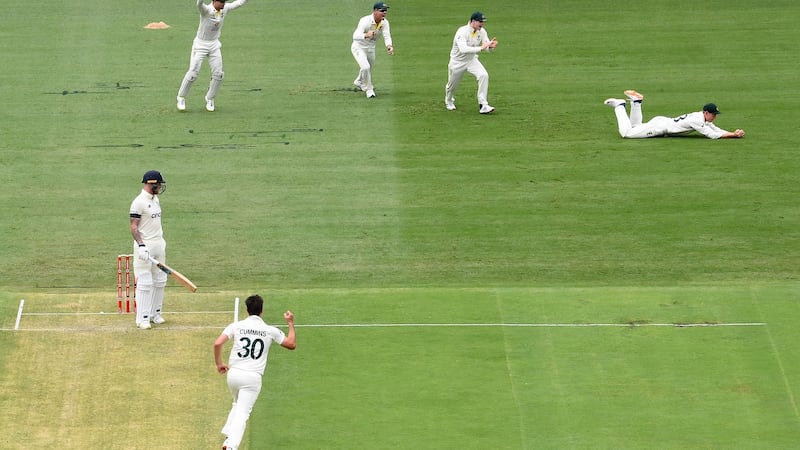England 147 all out (J Buttler 39, O Pope 35; P Cummins 5-38)
It was a first day in the job that seemed written in the southern stars for Pat Cummins, Australia’s newly-crowned Test captain claiming a five-wicket haul, watching his opposite number trudge off after a nine-ball duck and England’s batsmen left in a state of general bewilderment.
From the opening delivery of this pandemic-era Ashes, when Rory Burns displayed the footwork of an early Strictly evictee and Mitchell Starc speared the brand new Kookaburra ball into his leg stump, everything turned to Australian gold; for England, three for 11 in the blink of an eye and then all out for 147 in 50.1 overs, this represented the latest chapter in the great book of Gabba woes.
Even the storm that rolled in just moments after Joe Root’s tourists had been bowled out prevented a challenging final session with the bat under brooding Queensland skies. Instead Cummins was the enduring image, holding the ball aloft to stands almost in disbelief at figures of five for 38 from 13.1 overs and the start to proceedings that he and his new subordinates had made.
Surfing a wave of goodwill into this first Test, the 28-year-old need only look across to his opposite number for a reminder that things don’t always run so smoothly. Root announced the start of his own tenure back in 2017 with a celestial 190 against South Africa at Lord’s but 57 matches later he was left lamenting a nine-ball nought against his own name and England’s lowest first-innings total at the Gabba since their 134 all out in 1958.
It prompted Queensland police to tweet that they were investigating a group of individuals impersonating a Test batting order at the Gabba – interviewing all of the eye-witnesses may prove tricky here – but any charges relating to Root’s decision upon winning toss, and the absence of both Jimmy Anderson and Stuart Broad for the first time in 37 Ashes Tests, will likely split any jury.
Cummins said he had intended to bat first – Tim Paine’s successor seems too genuine to play mind games here, even if he also added it was a “50-50” call – but then the last four Test teams to bat first in Brisbane have gone on to lose. Nasser Hussain’s much-lamented bowl-first call in 2002 probably has a bit to answer for as regards English thoughts on the subject and certainly Australia’s much vaunted pace attack found conditions to their liking.
Burns said before the series he hadn’t really thought about facing the first ball of an away Ashes but it was a moment he will likely be reminded of every four years. The quirky left-hander has a tendency to plant the front foot outside off but, with perhaps a touch of added nerves, this was an exaggerated movement that exposed a leg stump met obligingly by Starc’s full, swinging delivery.
These things happen, albeit not too often, given it was just the second time an Ashes series has seen a wicket fall first ball after England’s Stan Worthington was removed by Ernie McCormack in Brisbane in 1936. But what followed from Josh Hazlewood, reducing England to 11 for three by the sixth over, proved a defining intervention from which recoveries were only fleeting.
Charging in from the Stanley Street End, Hazlewood produced a frankly immaculate spell of seven overs, two for three. Dawid Malan was caught between defending and leaving when the debutant Alex Carey pouched an edge behind, while Root was worked over on both sides of the bat before a ball that swung and seamed away was nicked to David Warner at first slip. Much was made of the Cummins-Root encounter before the first Test, but with eight dismissals it is Hazlewood who has now had the Yorkshireman’s number more than any other.
Cummins was not to be denied his first wicket before lunch, however. The return of Ben Stokes after a four-month break from cricket ended on five when Australia’s captain went around the wicket, squared up the all-rounder and yet more bounce from the green-tinged surface saw the shoulder of the bat taken for a diving catch at third slip.

All the while Haseeb Hameed had been playing solidly in defence, with he and Ollie Pope putting on a busy stand of 31 that helped England through to lunch. Though Hameed’s poise was a source of mild comfort for the blearly-eyed supporters back in the UK, his demise in the first over was a blow after 40 minutes of patience during the break as Cummins went fuller than before and a low-handed push forward offered the cordon another victim.
From the rubble of 60 for five England staged something of a counter-attack, Jos Buttler taking little time to overtake Pope as the innings top-scorer with a succession of lofted or laced drives from his playbook as a Twenty20 opener who enjoyed the field up in the powerplay. The cameo may have been ended when Starc angled one across the bat to present Carey with his second catch but the approach Buttler took looked encouraging for his tour as a whole.

So, too, was the fact that batting briefly looked easier against the spin of Nathan Lyon, in the hunt for his 400th Test wicket, and once Kookaburra had lost its early lacquer. As such, when Pope toe-ended a pull to Hazlewood at fine leg on 35 for the giant Cameron Green’s maiden Test wicket, it represented something of a gift. Still, over the course of 79 balls the Surrey man had just about justified a progressive selection ahead of Jonny Bairstow.
A startling problem from four years ago remains, however: England’s lower order against the short ball. Cummins, in fairness, was ruthless here, Ollie Robinson backing away as he drove loosely behind for the third duck of the innings, Mark Wood awkwardly caught at short leg off the bat handle and Chris Woakes the last man out for 21 via a near carbon copy of Pope’s earlier demise.
But a series that burst into life with an opening day of Cummins and goings at the Gabba will only go one way if England’s tail are once again unable to find a solution. – Guardian












